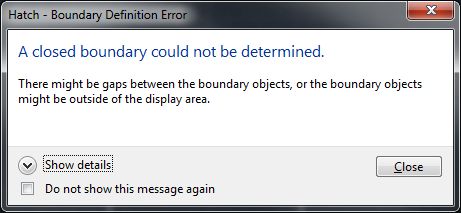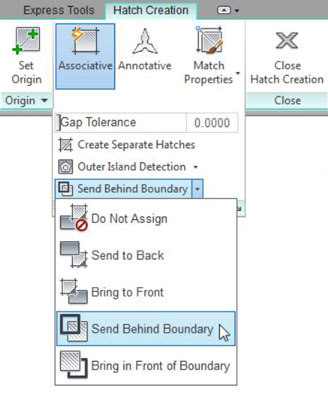On the Properties panel Hatch Type list, select the type of hatch that you want to use. On the Pattern panel, click a hatch pattern or fill. On the Boundaries panel, specify the how the pattern boundary is selected. Fills an enclosed area or selected objects with a hatch pattern, solid fill, or gradient fill. Find When the ribbon is active, the Hatch Creation contextual tab is displayed. When the ribbon is. If you modify the boundary objects of an associative hatch, and the result maintains a closed boundary, the associated hatch object is automatically updated. If the changes result in an open boundary, the hatch loses its associativity with the boundary objects, and the hatch remains unchanged. When trying to add a hatch to a drawing in AutoCAD, the following message is displayed: Hatch - Boundary Definition Error A closed boundary cannot be determined. There might be gaps between the boundary objects, or the boundary objects might be outside of the display area. Drawing a Hatch Boundary 'On the Fly' If you haven't yet drawn a polyline boundary for your hatch, you can now do so 'on the fly' after selecting your hatch pattern. When you go to place a hatch, the Command line will prompt you to Select polyline or interior point to hatch, Draw Exclude shrubs Multiple. Start drawing your closed polyline.
The BOUNDARY command is one of those tools that is mostly unknown and seldom gets used… which is a shame because it can be really useful. The BOUNDARY command draws a polyline by taking a point from the user, and looking for the boundary that encloses it. In other words, it returns the boundary that would be found if you used the “pick points” option from the HATCH command.

Normal Usage

Invoke the BOUNDARY command and you will get a little dialog box. You can choose to untick “Island detection”, and you can change the object type that is generated from polyline to region. Once this is set up click “Pick Points” at the top, and select a point on screen that is enclosed by other objects. As you’d expect objects that are hidden or frozen are not considered in the formation of a valid boundary.
Autocad Hatch Boundary Edit
Special Usage
One of the most intuative ways of using this tool is to retrieve the boundary of complex shapes. Consider the below arbitrary set of shapes:
If you wanted to convert this into a polyline boundary, how would you do it? A lot of people would just head directly to the TRIM command and start hacking away. The more AutoCAD® savvy person might take another approach… You probably gathered as you’re on the BOUNDARY page, that this can be achieved using the BOUNDARY command, but have you figured out how? How about when you consider this:
By using another boundary around the objects, you can pick a point in the area between the outer boundary and the set of shapes, and capture the outline of the complex shape as an island. Once you have your outline, just delete the bits you don’t want. This can be an extremely useful trick for very complex shapes, and can save a heck of a lot of time and effort.
Can't get AutoCAD to hatch an area? As frequently as this happens, I could have just titled this article 'Using Hatch in AutoCAD'. Among the mysteries of the universe is why a program that can build a scale 3-D model of the solar system cannot seamlessly perform some of the same functions that my Super Nintendo did in Mario Paint. An even bigger mystery is how to explain to your non-CAD coworkers why it took all afternoon to color a map.
Nevertheless, here are some tried-and-true 'solutions':
- Before hatching, do whatever you need to do to cut down the amount of data going on in your drawing. PURGE out anything you don't need. If you're one of those lazy users that always reuses the same file, and has ten different projects off to the side in model space, delete them and PURGE again. And turn off any layers you won't need during the hatching command.
- Draw a polygon around the area to be hatched, and delete it afterward. This doesn't actually make hatch work any better, but it's a good failsafe to practice in case your area doesn't hatch correctly. Instead of having hatch extend all the way to gosh-knows-where, it will only extend to the edge of the polygon, saving you a ton of time and a possible freeze.
- REGEN religiously.
- Pan out until you can see the entire area that will be hatched. This will help CAD process.
- Start with a simple pattern, then edit the pattern once you've finished hatching. Try something like 'DOTS' set to a scale of 1.00. AutoCAD won't get as confused trying to find the edges of the area, and once you have the hatch in place you can change it to look however you want.
- Change the Gap Tolerance setting. Type HATCH then T to access settings. You can then increase the gap tolerance. Honestly, it's never helped me, but theoretically it should.
- Cut and paste the area to be hatched into a separate DWG. After copying, open a new blank DWG. Right click and select Clipboard --> paste to original coordinates. PURGE to get rid of unnecessary stuff that may have come in with it. Then hatch, copy the hatch, and again paste to original coordinates.
- Use BPoly to turn separate plines into solid boundaries. This will help avoid holes.
- If you have a lot of plines or lines touching each other, use the JOIN command to make them into one unbroken piece. This will avoid potential 'leaks'. If you don't want the lines or plines joined together forever, cut and paste into a separate DWG first.
- Check that 'joined' lines are truly joined in a closed shape. Click on the joined object, pull up the properties pop-up (PROP command), look near the bottom of the pop-up, and you'll see an option 'closed'. If it is set to 'no', select 'yes'.
- Draw a couple of lines through the area to be hatched and hatch it by segments. You can either hatch one segment, then use HATCHEDIT to add more areas to your hatch, or make separate hatches. When hatching huge areas, I find it faster to make several hatches to fill the space. After you are done, of course, delete the lines or put them on a non-plotting layer.
- Make sure the HATCH scale is not extremely large or extremely small. This will slow down the computer.
Use an external program such as Canvas that can handle DWG images to do the hatching part.
Hatch a simple shape, such as a square, then right click to select draw order --> send to back, and place under the outlined area. This would work in a situation such as having several areas already hatched and an outlined area in between them that's having difficulty hatching.
- WHEN ALL ELSE FAILS, make an image elsewhere and add it to your AutoCAD DWG by either a PDF underlay or inserting an image such as a TIFF file. This will look terrible and cause its own set of problems, but if the board meeting is in 5 minutes and nothing else is working, this might just get you through, and look slightly better than filling it in with a Sharpie marker.
I hope you all enjoyed, and feel free to leave any more ideas in the comments section.
Also, and unrelated, I also write theology for the blog 10forJesus.com. Check it out if you're ready for a drastic change in subject material.

Autocad Modify Hatch Boundary
Sincerely,
Autocad Hatch Outside Boundary Wall
Morgan Grace Hart
